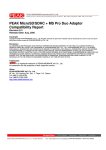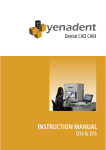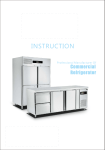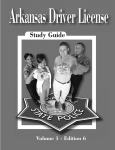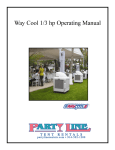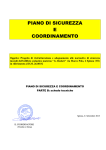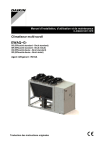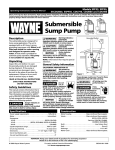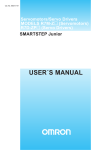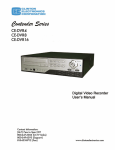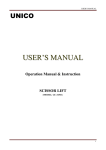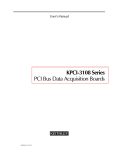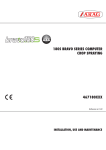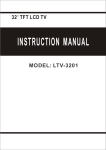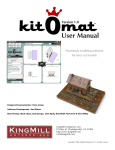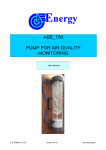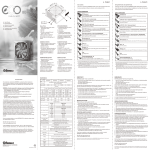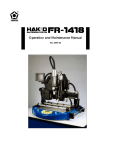Download ORIGINAL INSTRUCTIONS
Transcript
ORIGINAL INSTRUCTIONS FLYING CUT-OFF MACHINE TYPE A071 CS Manufacturer OFFICINE M.T.M. S.P.A. Serial number 11M254 Building year 2011 experience your innovation La riproduzione del presente manuale è vietata. OFFICINE M.T.M. S.P.A. (di seguito denominata "MTM") si riserva il diritto di apportare in qualsiasi momento le modifiche che ritenesse necessarie per il miglioramento della macchina. This manual copying is forbidden. OFFICINE M.T.M. S.P.A. (hereinafter referred to as "MTM") reserves the right of making the changes needed for the improvement of the machine in any moment. La reproduction de ce manuel est interdite. OFFICINE M.T.M. S.p.A. (ci-dessous appelée "MTM") se réserve le droit d’apporter à tout moment les modifications retenues comme nécessaires pour améliorer la machine. La reproducción del presente manual está prohibida. OFFICINE M.T.M. S.P.A. (en adelante "MTM") se reserva el derecho de aportar en cualquier momento las modificaciones que considere necesarias para el mejoramiento de la máquina. Воспроизводство настоящего руководства запрещено. Фирма ЗАВОДЫ КОМПАНИИ М.Т.М. С.П.А. (именуемой в дальнейшем «МТМ») оставляет за собой право внесения в любой момент изменений. MANUAL DATA Edition 01 Revision 07 Date 07/2012 MAIN TABLE OF CONTENTS 1 - MAIN TABLE OF CONTENTS pag. 1- MAIN TABLE OF CONTENTS . . . . . . . . . . . . . . . . . . . . . . . . . . . . . . . 1 - 1 2 - GENERAL SECTION . . . . . . . . . . . . . . . . . . . . . . . . . . . . . . . . . . . . . . 2 - 1 2.1 2.2 2.3 FOREWARD INTRODUCTION . . . . . . . . . . . . . . . . . . . . . . . . . . . . . . . . . . . . . . . . . . . . . . . . . . . . . . . . . . . . . . . . . . 2 - 2 2.2.1 PRESENTATION OF THE MANUAL . . . . . . . . . . . . . . . . . . . . . . . . . . . . . . . . . . . . . . . . . . . . 2 - 2 2.2.2 COMPONENTS IDENTIFICATION . . . . . . . . . . . . . . . . . . . . . . . . . . . . . . . . . . . . . . . . . . . . . . 2 - 8 2.2.3 MANUFACTURER . . . . . . . . . . . . . . . . . . . . . . . . . . . . . . . . . . . . . . . . . . . . . . . . . . . . . . . . . . 2 - 8 2.2.4 COMPONENTS TECHNICAL FEATURES . . . . . . . . . . . . . . . . . . . . . . . . . . . . . . . . . . . . . . . . 2 - 8 GENERAL DESCRIPTIONS - TECHNICAL SPECIFICATIONS . . . . . . . . . . . . . . . . . . . . . . . . . . . . . 2 - 10 2.3.1 2.4 . . . . . . . . . . . . . . . . . . . . . . . . . . . . . . . . . . . . . . . . . . . . . . . . . . . . . . . . . . . . . . . . . . . . .2 - 1 TECHNICAL DATA . . . . . . . . . . . . . . . . . . . . . . . . . . . . . . . . . . . . . . . . . . . . . . . . . . . . . . . . . 2 - 10 MACHINE INSTALLATION . . . . . . . . . . . . . . . . . . . . . . . . . . . . . . . . . . . . . . . . . . . . . . . . . . . . . . . . . . 2 - 11 2.4.1 TRANSPORT AND HANDLING . . . . . . . . . . . . . . . . . . . . . . . . . . . . . . . . . . . . . . . . . . . . . . . . 2 - 11 2.4.2 LIFTING AND HANDLING RULES . . . . . . . . . . . . . . . . . . . . . . . . . . . . . . . . . . . . . . . . . . . . . .2 - 13 2.4.3 LIFTING TYPOLOGY . . . . . . . . . . . . . . . . . . . . . . . . . . . . . . . . . . . . . . . . . . . . . . . . . . . . . . . . 2 - 14 2.4.4 MACHINE UNPACKING . . . . . . . . . . . . . . . . . . . . . . . . . . . . . . . . . . . . . . . . . . . . . . . . . . . . . 2 - 16 2.4.5 MACHINE STORAGE BEFORE START-UP . . . . . . . . . . . . . . . . . . . . . . . . . . . . . . . . . . . . . 2 - 16 2.4.6 INSTALLATION AND CONNECTIONS . . . . . . . . . . . . . . . . . . . . . . . . . . . . . . . . . . . . . . . . . . 2 - 16 2.5 PERSONNEL TRAINING . . . . . . . . . . . . . . . . . . . . . . . . . . . . . . . . . . . . . . . . . . . . . . . . . . . . . . . . . . .2 - 17 2.6 MACHINE ADJUSTMENT . . . . . . . . . . . . . . . . . . . . . . . . . . . . . . . . . . . . . . . . . . . . . . . . . . . . . . . . . 2 - 18 2.7 2.6.1 SETTING-UP ADJUSTMENTS . . . . . . . . . . . . . . . . . . . . . . . . . . . . . . . . . . . . . . . . . . . . . . . 2 - 18 2.6.2 ADJUSTMENT DURING PRODUCTION . . . . . . . . . . . . . . . . . . . . . . . . . . . . . . . . . . . . . . . . 2 - 18 INSTRUCTIONS FOR MACHINE USE . . . . . . . . . . . . . . . . . . . . . . . . . . . . . . . . . . . . . . . . . . . . . . . 2 - 19 2.7.1 MACHINE USE . . . . . . . . . . . . . . . . . . . . . . . . . . . . . . . . . . . . . . . . . . . . . . . . . . . . . . . . . . . . 2 - 19 2.7.2 DESCRIPTION OF OPERATING MODES . . . . . . . . . . . . . . . . . . . . . . . . . . . . . . . . . . . . . . . 2 - 19 2.7.3 ACOUSTIC NOISE PRODUCED BY THE MACHINE . . . . . . . . . . . . . . . . . . . . . . . . . . . . . . 2 - 20 2.7.4 SAFETY PRECAUTIONS . . . . . . . . . . . . . . . . . . . . . . . . . . . . . . . . . . . . . . . . . . . . . . . . . . . . .2 - 21 2.7.5 SAFETY SIGNS ON THE MACHINES . . . . . . . . . . . . . . . . . . . . . . . . . . . . . . . . . . . . . . . . . . 2 - 22 2.7.6 SOFTWARE SAFETY PRECAUTIONS . . . . . . . . . . . . . . . . . . . . . . . . . . . . . . . . . . . . . . . . . 2 - 24 2.7.7 SAFETY PROTECTIONS . . . . . . . . . . . . . . . . . . . . . . . . . . . . . . . . . . . . . . . . . . . . . . . . . . . . 2 - 25 2.7.8 RESTRICTIONS OF USE . . . . . . . . . . . . . . . . . . . . . . . . . . . . . . . . . . . . . . . . . . . . . . . . . . . . 2 - 27 2.7.9 PREVENTION OF RISKS CAUSED BY MOBILE ELEMENTS . . . . . . . . . . . . . . . . . . . . . . 2 - 27 2.7.10 MACHINE SAFE OPERATION . . . . . . . . . . . . . . . . . . . . . . . . . . . . . . . . . . . . . . . . . . . . . . . . 2 - 27 2.7.11 11M254 PRECAUTIONS TO BE ADOPTED DURING THE OPERATION . . . . . . . . . . . . . . . . . . . . . 2 - 28 Edition 01 Revision 07 1-1 MAIN TABLE OF CONTENTS pag. 2.8 MAINTENANCE REQUIREMENTS . . . . . . . . . . . . . . . . . . . . . . . . . . . . . . . . . . . . . . . . . . . . . . . . . . 2 - 29 2.8.1 SPECIAL MAINTENANCE . . . . . . . . . . . . . . . . . . . . . . . . . . . . . . . . . . . . . . . . . . . . . . . . . . . 2 - 29 2.9 TROUBLE SHOOTING . . . . . . . . . . . . . . . . . . . . . . . . . . . . . . . . . . . . . . . . . . . . . . . . . . . . . . . . . . . . 2 - 30 2.10 REPAIR AND REPLACEMENT OF PARTS . . . . . . . . . . . . . . . . . . . . . . . . . . . . . . . . . . . . . . . . . . . .2 - 31 2.11 MOVING THE MACHINE . . . . . . . . . . . . . . . . . . . . . . . . . . . . . . . . . . . . . . . . . . . . . . . . . . . . . . . . . . 2 - 32 2.11.1 SETTING THE MACHINE OUT OF SERVICE . . . . . . . . . . . . . . . . . . . . . . . . . . . . . . . . . . . . 2 - 32 2.11.2 DISASSEMBLE AND PACKAGE . . . . . . . . . . . . . . . . . . . . . . . . . . . . . . . . . . . . . . . . . . . . . . 2 - 32 2.11.3 TRANSPORT . . . . . . . . . . . . . . . . . . . . . . . . . . . . . . . . . . . . . . . . . . . . . . . . . . . . . . . . . . . . . 2 - 32 2.11.4 INSTALLATION . . . . . . . . . . . . . . . . . . . . . . . . . . . . . . . . . . . . . . . . . . . . . . . . . . . . . . . . . . . . 2 - 32 2.12 DEMOLITION OF THE MACHINE . . . . . . . . . . . . . . . . . . . . . . . . . . . . . . . . . . . . . . . . . . . . . . . . . . . 2 - 33 2.13 INTERVENTION REQUEST - TECHNICAL SERVICE . . . . . . . . . . . . . . . . . . . . . . . . . . . . . . . . . . . . 2 - 34 2.13.1 TECHNICAL SERVICE . . . . . . . . . . . . . . . . . . . . . . . . . . . . . . . . . . . . . . . . . . . . . . . . . . . . . . 2 - 35 2.14 WARRANTY . . . . . . . . . . . . . . . . . . . . . . . . . . . . . . . . . . . . . . . . . . . . . . . . . . . . . . . . . . . . . . . . . . . . 2 - 37 2.15 ORIGINAL SPARE PARTS . . . . . . . . . . . . . . . . . . . . . . . . . . . . . . . . . . . . . . . . . . . . . . . . . . . . . . . . 2 - 38 2.16 LIST OF TECHNICAL DOCUMENTS CONCERNING THIS MANUAL . . . . . . . . . . . . . . . . . . . . . . . 2 - 39 3 - FLYING CUT-OFF MACHINE – TYPE A071 CS . . . . . . . . . . . . . . . . . 3 - 1 3.1 DESCRIPTION . . . . . . . . . . . . . . . . . . . . . . . . . . . . . . . . . . . . . . . . . . . . . . . . . . . . . . . . . . . . . . . . . . . 3 - 2 3.2 FUNCTION AND ADJUSTMENTS . . . . . . . . . . . . . . . . . . . . . . . . . . . . . . . . . . . . . . . . . . . . . . . . . . . . 3 - 2 3.2.1 3.3 3.2.2 INFEED CENTRING UNIT . . . . . . . . . . . . . . . . . . . . . . . . . . . . . . . . . . . . . . . . . . . . . . . . . . . . 3 - 4 3.2.3 FLYING CUT-OFF MACHINE GEAR UNIT . . . . . . . . . . . . . . . . . . . . . . . . . . . . . . . . . . . . . . . 3 - 5 3.2.4 FLYING CUT-OFF CARRIAGE WITH CUTTING UNIT AND VICES . . . . . . . . . . . . . . . . . . . . 3 - 7 3.2.5 CUTTING UNIT . . . . . . . . . . . . . . . . . . . . . . . . . . . . . . . . . . . . . . . . . . . . . . . . . . . . . . . . . . . . . 3 - 8 3.2.6 PROTECTION TUNNEL (OPTIONAL) . . . . . . . . . . . . . . . . . . . . . . . . . . . . . . . . . . . . . . . . . . . 3 - 13 OPERATION . . . . . . . . . . . . . . . . . . . . . . . . . . . . . . . . . . . . . . . . . . . . . . . . . . . . . . . . . . . . . . . . . . . . 3 - 14 3.3.1 TOOL REPLACEMENT . . . . . . . . . . . . . . . . . . . . . . . . . . . . . . . . . . . . . . . . . . . . . . . . . . . . . . .3 - 15 3.4 BUSH REPLACEMENT ON THE RACK SUPPORT . . . . . . . . . . . . . . . . . . . . . . . . . . . . . . . . . . . . . .3 - 16 3.5 RACK REPLACEMENT . . . . . . . . . . . . . . . . . . . . . . . . . . . . . . . . . . . . . . . . . . . . . . . . . . . . . . . . . . . . . 3 - 17 3.6 INSTALLATION . . . . . . . . . . . . . . . . . . . . . . . . . . . . . . . . . . . . . . . . . . . . . . . . . . . . . . . . . . . . . . . . . . .3 - 18 3.7 3.8 11M254 FLYING CUT-OFF METERING UNIT . . . . . . . . . . . . . . . . . . . . . . . . . . . . . . . . . . . . . . . . . . . . 3 - 2 3.6.1 FOUNDATIONS . . . . . . . . . . . . . . . . . . . . . . . . . . . . . . . . . . . . . . . . . . . . . . . . . . . . . . . . . . . .3 - 18 3.6.2 ELECTRIC INSTALLATION . . . . . . . . . . . . . . . . . . . . . . . . . . . . . . . . . . . . . . . . . . . . . . . . . . . .3 - 18 LUBRICATION . . . . . . . . . . . . . . . . . . . . . . . . . . . . . . . . . . . . . . . . . . . . . . . . . . . . . . . . . . . . . . . . . . . .3 - 19 3.7.1 CUT-OFF MACHINE . . . . . . . . . . . . . . . . . . . . . . . . . . . . . . . . . . . . . . . . . . . . . . . . . . . . . . . . .3 - 19 3.7.2 METERING UNIT . . . . . . . . . . . . . . . . . . . . . . . . . . . . . . . . . . . . . . . . . . . . . . . . . . . . . . . . . . 3 - 22 WARNINGS . . . . . . . . . . . . . . . . . . . . . . . . . . . . . . . . . . . . . . . . . . . . . . . . . . . . . . . . . . . . . . . . . . . . 3 - 23 Edition 01 Revision 07 1-2 GENERAL SECTION FOREWARD 2 - GENERAL SECTION 2.1 FOREWARD This manual is a guide for the correct and safe use of the machine and for its rational maintenance. For this reason, we specify that the personnel operating the machine will always be identified in this manual depending on the operations to be carried out, as 2nd grade operator: skilled, authorised, equipped; “informed” operator. The constant compliance with the standards contained in this manual ensures best performances, cost-effective operation, and machine long life and avoids common causes of accidents, which may occur during work or maintenance. In designing and manufacturing the machine, the obligations imposed to the operator of using, if necessary or expected, the individual protection equipment (e.g. shoes, gloves, glasses, ear protectors, overalls, etc.) have been taken into account. This manual is an integral part of the machine and, therefore, the personnel operating and maintaining the machine must be enabled to easily make reference to it at any time. The descriptions and pictures provided in this manual are not binding. MTM reserves the right of making the changes that may be convenient for improvement purposes without undertaking to update these documents. For further clarifications, contact MTM offices, which are available for any useful information. 11M254 Edition 01 Revision 07 2-1 GENERAL SECTION INTRODUCTION 2.2 INTRODUCTION 2.2.1 PRESENTATION OF THE MANUAL NOTE ON RECEIVING THE MACHINE, BEFORE PROCEEDING TO ASSEMBLE OR MOVE, READ THE USER GUIDE AND MAINTENANCE MANUALS CAREFULLY. This manual contains instructions on how to handle, install, maintain, operate and adjust the machine in question. The manual is made up of various sections (in booklet form), each of which covers a series of topics, subdivided into chapters and paragraphs which deal with a precise application of the plant. Section 2 - GENERAL SECTION contains a series of information regarding the all plant, with particular regard to safety and handling. The following sections, however, describe the individual machines of the plant in detail. Each section is divided up into topics, each topic describing a series of operations in full. The general table of contents constituent section 1, lists all the topics covered in the whole manual. The numbering of the pages of each section is independent and consists in a progressive number preceded by the number of the section to which the page belongs (e.g. 2-5 is page n° 5 of section 2). This manual is intended for use by the personnel in charge of the installation, use, maintenance and demolition of the machine, and is related to the technical life of the machine subsequent to its manufacture and sale. In the event the machine is subsequently transferred to a third party for any reason (sale, free loan, or any other reason), the machine must be handed over complete with all the documents. The information contained in this manual is not intended as a substitute for the knowledge and experience possessed by the customer using the machine, who is fully responsible for the performance of the operations for which the machine was purchased. Before starting any operation on any unit, the person in question must have at least read the whole manual and subsequently given greater attention to the topic relating to the work to be performed. This manual contains copyright information and cannot be furnished to third parties, even in part, for any purpose and in any form without MTM's prior written consent. MTM hereby declares that the information contained in this manual is consistent with the technical and safety specifications of the machine the manual refers to. A true copy of this manual is filed in the machine's technical folder which is kept at MTM's offices. MTM shall not recognize any documents which have not been produced, released or distributed by MTM. 11M254 Edition 01 Revision 07 2-2 GENERAL SECTION INTRODUCTION 2.2.1.1 GRAPHIC CONVENTIONS In order to make the topics more immediately comprehensible, graphic and typographic symbols and conventions have been adopted throughout the manual, and are described below: NOTE THE NOTES CONTAIN IMPORTANT INFORMATION AND ARE HIGHLIGHTED ALONGSIDE THE TEXT THEY REFER TO. AT T E N T I O N THE CAUTION INSTRUCTIONS INDICATE THOSE PROCEDURES WHERE FAILURE TO FULLY COMPLY THEREWITH MAY RESULT IN DAMAGE TO THE MACHINE OR OTHER EQUIPMENT CONNECTED TO IT. DANGER THE DANGER INSTRUCTIONS INDICATE THOSE PROCEDURES WHERE FAILURE TO FULLY COMPLY THEREWITH MAY RESULT IN DAMAGE OR INJURY TO THE OPERATOR OR OTHER PEOPLE NEARBY. Warning Attention. Operation to be performed by qualified personnel for assistance on electrical equipment. Burn hazard. Texts to be read with particular care. Texts containing information of particular relevance. Addresses / contacts. Information regarding the packaging of the various components. 11M254 Edition 01 Revision 07 2-3 GENERAL SECTION INTRODUCTION Information on transportation by truck. Information on transportation by ship. Information on transport and handling. Danger suspended load. Information regarding adjustment procedures. Information regarding acoustic noise. Ear protection is compulsory. Body protection is compulsory. Machine downtime. Information regarding the machine fixing to the floor. Lubricant loading. Information regarding greasing / lubrication. Pressure greasing. Manual greaasing. 11M254 Edition 01 Revision 07 2-4 GENERAL SECTION INTRODUCTION COUNTER CLOCK WISE rotation of the horizontal screw. CCW CW CLOCK WISE rotation of the horizontal screw. . CW CLOCK WISE rotation of the vertical screw. . CCW COUNTER CLOCK WISE rotation of the vertical screw. CW CLOCK WISE rotation of the component. CCW COUNTER CLOCK WISE rotation of the component. Vertical movement of the component. Horizontal movement of the component. 2.2.1.2 Wording in italics 11M254 TYPOGRAPHIC CONVENTIONS Used to indicate reference to figures, chapters or topics other than the current ones. Edition 01 Revision 07 2-5 GENERAL SECTION INTRODUCTION 2.2.1.3 UNITS OF MEASUREMENT – INTERNATIONAL SYSTEM (SI) Basic SI units Length meter m Mass kilogram kg Time second s Electric current ampere A Thermodynamic temperature kelvin K Angular measure radian rad SI derived units 11M254 Strength newton N Pressure pascal Pa Energy joule J Power watt W Voltage volt V Frequency hertz Hz Capacitance farad F Electrical resistance ohm Ω Edition 01 Revision 07 2-6 GENERAL SECTION INTRODUCTION SI prefixes 11M254 Edition 01 tera T 1012 1 000 000 000 000 giga G 109 1 000 000 000 mega M 106 1 000 000 kilo k 103 1 000 hecto h 102 100 deca da 101 10 deci d 10-1 0.1 centi c 10-2 0.01 milli m 10-3 0.001 micro µ 10-6 0.000 001 nano n 10-9 0.000 000 001 pico p 10-12 0.000 000 000 001 Revision 07 2-7 GENERAL SECTION INTRODUCTION 2.2.2 COMPONENTS IDENTIFICATION The machine model is shown on the nameplate located on the upper right corner of the Main Electric Cabinet. It bears the following data: MANUFACTURER: OFFICINE M.T.M. S.P.A. MACHINE MODEL: FLYING CUT-OFF MACHINE TYPE A071 CS SERIAL NUMBER: 11M254 YEAR OF CONSTRUCTION: 2011 2.2.3 MANUFACTURER The machine described in this user’s manual and the models deriving from it are manufactured and sold by: Officine M.T.M. S.P.A. via Palladio 36 | 30038 Spinea Venezia | Italy tel +39 041 5089611 | fax +39 041 999611 www.mtmtubemills.com 2.2.4 COMPONENTS TECHNICAL FEATURES The machine manufactured by MTM consists of: • Flying cut-off machine type A71 CS • Cut-off entry guide • Metering wheel • Pneumatic and lubrication unit • Electric cabinet • Control board 11M254 Edition 01 Revision 07 2-8 GENERAL SECTION INTRODUCTION 1 7 5 1 7 4 5 3 2 2 1 7 6 3 1- Flying cut-off machine type A71 CS 2- Cut-off entry guide 3- Metering wheel 4- Pneumatic and lubrication unit 5- Electric cabinet 6- Control board 7- Protection tunnel (optional) Fig. 2-A General view of the machine 11M254 Edition 01 Revision 07 2-9 GENERAL SECTION GENERAL DESCRIPTIONS - TECHNICAL SPECIFICATIONS 2.3 GENERAL DESCRIPTIONS - TECHNICAL SPECIFICATIONS 2.3.1 TECHNICAL DATA 2.3.1.1 MATERIAL SPECIFICATIONS • Material to be processed: Carbon steel • Max tensile strength: 550 N/mm² • Type of production: Round, Square and Rectangular tube • Tube diameter: MIN ¾” - MAX 3” • Thickness: MIN .026” - MAX .156” • Final tube Length: MIN 4.0 m - MAX 8.0 m 2.3.1.2 MAIN TECHNICAL FEATURES • Mechanically predisposed speed: MAX 150 m/min 11M254 • Cutting process: Cold Saw • Cutting tollerance: ± 1.5 mm • Cutting head movement: Electro-mechanical • Tube clamping: Mechanical, pneumatically actuated • Saw drive: Electric motor with variable speed converter • Saw carriage drive: Elecric motor through pinion and rack • Cuts per minute: MAX 25/min on 6 meters lenght tubes • Direction of operation: Right to Left • Mill pass line from floor: 1000 mm • Voltage: 480 V – 60 Hz Edition 01 Revision 07 2-10 GENERAL SECTION MACHINE INSTALLATION 2.4 MACHINE INSTALLATION 2.4.1 TRANSPORT AND HANDLING DANGER WARNING! SKILLED PERSONNEL TRAINED FOR THIS TYPE OF OPERATIONS MUST CARRY OUT HANDLING AND LIFTING OPERATIONS. In order to facilitate transport operations and depending on requirements, MTM transports its machines either assembled or disassembled into their parts. All the machine mechanical parts are protected using protective paints and/or protective oil before shipping them. Instead, electrical parts are protected with plastic films, and bags containing dehydrating salts are put inside. The load is then fastened by means of ropes and belts. AT T E N T I O N MAKE SURE THAT, WHERE THE BELTS/ROPES TOUCH THE MACHINE, SUITABLE PROTECTIONS OF THE CONTACT SURFACE ARE PLACED IN ORDER NOT TO DAMAGE IT. The plant accessories, regardless of the means of transport used, are generally packed in wooden cases, lined with shock-resistant blister polyethylene sheets. In case of transport by sea, dehydrating salt bags will also be used. In addition, MTM makes custom-made packaging on customer’s requests or due to special requirements (size or material fragility). Machines are loaded in bulk on both boxes and containers. After the arrival at the customer’s premises, the machines and cases will have to be handled very carefully using equipment having a carrying capacity adequate to the weight to be lifted and handled both indoor and outdoor. If the anchoring instructions are not complied with, there is the risk that the machine or the case overturns or falls (see lifting diagrams in the following chapter). The described solutions also apply in case the machine or parts of it are lifted or handled by the customer or in case of future movements. For the cases, the standard transport modalities apply. Two different transport solutions can be adopted to deliver the machine to the user, namely: a) Truck The machine is loaded on low-bed or standard trucks always covered by tarpaulin, which must ensure the protection of the load against atmospheric agents. We recommend to always check the covering tarpaulin integrity. 11M254 Edition 01 Revision 07 2-11 GENERAL SECTION MACHINE INSTALLATION b) Ship The machine is loaded on board by 40’ or 20’ open-top containers or wooden boxes coated with tarpaper and lined with nylon. We recommend to always check the covering tarpaulin integrity. AT T E N T I O N TRANSPORT TEMPERATURE: FROM -25°C TO +55°C, UP TO + 70°C FOR NOT MORE THAN 24H. 11M254 Edition 01 Revision 07 2-12 GENERAL SECTION MACHINE INSTALLATION 2.4.2 LIFTING AND HANDLING RULES MTM machines, including their related general electric boards, are fitted with adequate lifting connections and/or eyebolts, which are integral part of the machine and designed according to its weight. In order to lift and handle the machine safely, observe the following recommendations: DANGER DO NOT STAND OR PASS UNDER SUSPENDED LOADS AND IN THE AREAS WHERE SAID LOADS ARE LIKELY TO FALL, EVEN WHEN TRANSLATION MOVEMENTS ARE NOT CARRIED OUT; • The lifting and transport equipment must only be used by authorised personnel; • the lifting and transport equipment must be adequate to the load characteristics, shape and volume as well as to the operating conditions; • the efficiency of the equipment, and in particular ropes, metal cables, chains, hooks must be checked and possible irregularities must be pointed out; • the carrying capacity of the equipment must be complied with; • check that the equipment and load path is free from any obstacle; • check that the operating station allows perfect visibility; • make sure that the loads are correctly slung, preventing the ropes from sliding on both the load and the hook and preventing them from slipping on sharp edges; bends with small radius of curvature and multiple torsion; • ensure the means and load stability; • ensure that the hook does not stick to fixed structures; • place the hooks in a barycentric position and do not pull slantwise to avoid dangerous oscillations when the load is lifted from the resting surface; • make sure that, where the belts/ropes touch the load, suitable protections are placed in order not to damage these surfaces; • lift the load, first as high as to check if it is balanced, then lift it at regular speed to the height needed to safely pass over all the obstacles which may be found along the route; • slowly place the load on suitable resistant supports and make sure that it cannot overturn after loosening the slings; • remove possible slings from the hook and lift it as high as to prevent the danger of knocking it. DANGER IF THESE OPERATIONS HAVE NOT BEEN CORRECTLY CARRIED OUT, THERE IS STILL THE RISK MTM DECLINES ANY RESPONSIBILITY. IT IS RECOMMENDED THAT SKILLED PERSONNEL TRAINED FOR THIS TYPE OF OPERATIONS CARRY OUT HANDLING AND LIFTING OPERATIONS. THAT THE MACHINE, CASES AND ELECTRIC BOARD OVERTURN OR FALL. IN ANY CASE, 11M254 Edition 01 Revision 07 2-13 GENERAL SECTION MACHINE INSTALLATION Some drawings showing the anchoring points of the lifting equipment and the weights of each machine are given here below. REMAINING RISK - CHECK ALL LIFTING EQUIPMENT; - ENSURE THE HOOKS ARE SUITABLE TO THE CAPACITY AND EFFICIENT. 2.4.3 LIFTING TYPOLOGY Fig. 2-B TYPE 1 Fig. 2-C TYPE 2 Fig. 2-D TYPE 3 A CABLE A CABLE A CABLE B HOOK B HOOK B HOOK C ROLLER C ROLLER C BELT D EYEBOLT D HANGER Fig. 2-E TYPE 4 A CABLE Fig. 2-F TYPE 5 A LIFTING DEVICE B TUBE 11M254 Edition 01 Revision 07 2-14 GENERAL SECTION MACHINE INSTALLATION TECHNICAL DATA MACHINE MODEL CUT-OFF MACHINE OVERHEAD TRAVELING CRANE OR CRANE LIFTING TYPOLOGY TYPE 2/5 WEIGHT ~ Kg 7000 TECHNICAL DATA MACHINE MODEL ELECTRIC CABINET OVERHEAD TRAVELING CRANE OR CRANE LIFTING TYPOLOGY TYPE 1 WEIGHT ~ Kg 800 TECHNICAL DATA MACHINE MODEL CONTROL BOARD OVERHEAD TRAVELING CRANE OR CRANE LIFTING TYPOLOGY TYPE 2 WEIGHT ~ 11M254 Edition 01 Revision 07 190 Kg 2-15 GENERAL SECTION MACHINE INSTALLATION As for the lifting and transport of the cases containing accessories or parts or the plant, the same rules listed at the beginning of this chapter apply. DANGER SKILLED PERSONNEL TRAINED FOR THIS TYPE OF OPERATIONS MUST CARRY OUT HANDLING AND LIFTING OPERATIONS. 2.4.4 MACHINE UNPACKING The machine parts and the cases containing accessories or plant parts must be unpacked with care according to good technique standards, avoiding damages and faults that may compromise the machine good operation. DANGER THEREFORE, WE RECOMMEND THAT SKILLED PERSONNEL TRAINED FOR THIS TYPE OF OPERATIONS CARRY OUT UNPACKING OPERATIONS. MTM is not responsible for problems in installing the machine caused by damages occurred during the transport, handling and unpacking of the machine and of all its parts. 2.4.5 MACHINE STORAGE BEFORE START-UP When arriving by the customer and before start-up, the machine must be stored by the MTM authorised technical personnel in premises ensuring its protection from bad weather, from the atmospheric agents and from any cause or external agent which may damage it (e.g. chemical agents, dust, shocks, etc.). In particular: AT T E N T I O N STORAGE TEMPERATURE: FROM -25°C TO +55°C, UP TO 70°C FOR NOT MORE THAN 24H. 2.4.6 INSTALLATION AND CONNECTIONS Before sending the machine, MTM will send the layout showing the arrangement of the bases and the connections to the distribution networks for power requirements (electric power, water, air, oil, etc.). The installation, connections, and testing must only be carried out under the control of MTM TECHNICAL ASSISTANCE PERSONNEL or, alternatively, according to the previous agreements with MTM and to its authorisations. The great technological content of this machine does not allow the user to intervene in the above-mentioned operations, excepted that in the presence of MTM AUTHORIZED ENGINEERS or, alternatively, according to the previous agreements with MTM and to its authorisations. 11M254 Edition 01 Revision 07 2-16 GENERAL SECTION PERSONNEL TRAINING 2.5 PERSONNEL TRAINING During the machine installation, the personnel selected by the customer will be trained in the machine use. We recommend to select the skilled personnel in advance taking into account that, in relation to the its great technological level, the machine must be operated by skilled personnel having a great experience in using similar machines. The personnel training ends when the plant is started, unless otherwise agreed; in this case reference will be made to the order confirmation subscribed by both parties. This phase is defined by the “starting report” where the names of the people trained in the machine use will be listed. 11M254 Edition 01 Revision 07 2-17 GENERAL SECTION MACHINE ADJUSTMENT 2.6 MACHINE ADJUSTMENT For machine adjustments are meant all the adjustments to be carried out to obtain the maximum machine operating performance. They are subdivided into: • Setting-up adjustments • Adjustment during production 2.6.1 SETTING-UP ADJUSTMENTS They are the ones made during machine testing and installation or in case of operation restoring after a period of stop. The machine setting-up adjustment is only carried out by MTM personnel or, alternatively, according to the previous agreements with MTM and to its authorisations. It is carried out in collaboration with the personnel operating the machine, which will provide the data concerning the production specifications to MTM engineers. 2.6.2 ADJUSTMENT DURING PRODUCTION They are carried out and repeated by the trained personnel according to the requirements resulting from the machine normal use. As for the latter ones, make reference to the technical forms concerning each machine. DANGER SKILLED PERSONNEL TRAINED IN THIS TYPE OF OPERATIONS ONLY MUST CARRY OUT ADJUSTMENT OPERATIONS. 11M254 Edition 01 Revision 07 2-18 GENERAL SECTION INSTRUCTIONS FOR MACHINE USE 2.7 INSTRUCTIONS FOR MACHINE USE All the above operations are controlled through sophisticated electronic equipment consisting of electric panels, control boards, monitoring systems and control boxes. Operators trained by MTM engineers (see chapter 2.5 PERSONNEL TRAINING (pag. 2-17)) control all the operating modes above described. 2.7.1 MACHINE USE Personnel trained in its use can only operate the machine. The machine control operations are described in detail in the enclosed User’s manual for the supervisor. The technical forms concerning the machines making up the line are included in the present manual. 2.7.2 DESCRIPTION OF OPERATING MODES The plant in question has two operating modes: manual mode and automatic mode. 2.7.2.1 MANUAL MODE The operator may decide to work in manual mode for the following reasons: • fine tuning of the machine; • resolution of any problems when operating in automatic cycle. 2.7.2.2 AUTOMATIC MODE The machine must always work in automatic mode. The operator has only to check the potential problems (see the video pages). 11M254 Edition 01 Revision 07 2-19 GENERAL SECTION INSTRUCTIONS FOR MACHINE USE 2.7.3 ACOUSTIC NOISE PRODUCED BY THE MACHINE During design the lowering of the noise threshold has been especially evaluated. However, the requirements deriving from the machine normal operation do not allow its complete soundproofing by suitable acoustic insulating materials. Therefore, the operator will have to wear ear protectors. The system noise changes as the test position changes. Measurements carried out with the machine operating without tube in production differ from the ones carried out with the tube on line. With the tube in production the noise is very high and the operators will have to wear ear protectors. The level of acoustic pressure hereinafter described has been detected on a machine identical to the one object of this manual, under normal operating conditions and during the production of steel tubes and profiles at the speed of 130 m/min. For measuring the real level of acoustic pressure, a noise meter mod. DELTA OHM HD8701 having the following characteristics has been used: • Measure range (Autorange) 40÷130 dB • Frequency Response Weighted mean A Being the machine very long, and the working position variables, The acoustic pressure level has been measured at 1 m from the surface of the machine and at 1.60 m height above the ground near the working areas listed below. The actual measurement of the acoustic pressure level, carried out during production, is the following: • Cut-off machine area 11M254 Edition 01 Revision 07 < 80 dB 2-20 GENERAL SECTION INSTRUCTIONS FOR MACHINE USE 2.7.4 SAFETY PRECAUTIONS AT T E N T I O N THE MANUFACTURER IS NOT RESPONSIBLE FOR DAMAGES TO PEOPLE OR OBJECTS RESULTING FROM NON-COMPLIANCE WITH THE SAFETY STANDARDS. SKILLED PERSONNEL EXPERIENCED IN THE USE OF SIMILAR MACHINES MUST OPERATE THE MACHINE. The machine can be considered safe if it has been designed to be used, adjusted, maintained, dismantled and eliminated in its expected use conditions without causing injuries or damages to health. In order to achieve this aim, MTM has adopted the following measures: a) Reduction of risks starting from design. During design, the expected use, space and time restrictions have been taken into consideration. The dangers have been identified and all the dangerous situations have been evaluated considering: • the different aspects of the operator-machine relation • the possible machine states • the reasonable and expected use b) Protection measures. On the basis of the analysis in point a), protections have been studied and designed: • A - protections from transmission mobile components; • B - protections from mobile components involved in working. In both cases, protection consists of fixed, mobile and electronic devices. The machine is fitted with devices for the protection of the operator from the risks deriving from noise and vibrations. c) Use information. The machine is fitted with danger and warning signs and operating instructions. d) Personal means of protection. MTM has taken into account that the operators controlling the machine are always equipped with the following personal protection devices: helmet, ear protectors, glasses, accident-preventing shoes, overall. e) The indication of some written procedure the users must apply. 11M254 Edition 01 Revision 07 2-21 GENERAL SECTION INSTRUCTIONS FOR MACHINE USE 2.7.5 SAFETY SIGNS ON THE MACHINES For a more efficacy safety action, some accident prevention plates, concerning specific safety rules, danger conditions, obligations or prohibitions, have been fixed on the machines. In some specific case the application of these signs is referred to the present safety regulations. SIGNS GIVING ORDERS Do not smoke and do not use flames Entry forbidden to pedestrians Do not use water to extinguish the flames Entry forbidden to unauthorised persons Do not smoke Non drinkable water Entry forbidden to trucks and forklifts Do not touch Do not remove protection devices Fig. 2-G Signs giving orders 11M254 Edition 01 Revision 07 2-22 GENERAL SECTION INSTRUCTIONS FOR MACHINE USE (1) In absence of a specific high temperature control. Fig. 2-H Warning signs 11M254 Edition 01 Revision 07 2-23 GENERAL SECTION INSTRUCTIONS FOR MACHINE USE COMPULSORY SIGNS Eye protection is compulsory Breathing protection is compulsory Face protection is compulsory Safety gloves are compulsory Safety footwear is compulsory Warning (with possible additional sign) Safety helmets are compulsory Ear protection is compulsory Body protection is compulsory Individual protection against falls is compulsory Compulsory path for pedestrian Lifting point Fig. 2-I Compulsory signs 2.7.6 SOFTWARE SAFETY PRECAUTIONS Software installed on personal computers of the control boards is tested and controlled by MTM before delivery, in order to avoid presence of any “virus”. MTM is not responsible for any virus present in the system and recommends that the customer provides its computer systems with a suitable antivirus program. The antivirus program will have to be installed by a skilled engineer and, to be considered reliable, it will have to be continuously updated. Back up copies of the operative programs is supplied together with the electric documentation. 11M254 Edition 01 Revision 07 2-24 GENERAL SECTION INSTRUCTIONS FOR MACHINE USE 2.7.7 SAFETY PROTECTIONS Each MTM machine is fitted with protections in order to avoid injuries and damages to the health of the operators. DANGER PROTECTIONS ARE DESIGNED ACCORDING TO THE STANDARDS LISTED IN PARAGRAPH “FOREWORD”. AS FOR PERIMETRAL PROTECTIONS MTM HAS IDENTIFIED, DURING DESIGN PHASE, POSSIBLE RISKS AND DANGERS THAT MAY OCCUR TO USERS IN CASE OF NONINSTALLATION, AND HAS INFORMED CUSTOMER OF THOSE OCCURRENCES. AT T E N T I O N IN DESIGNING AND MANUFACTURING THE PROTECTIONS DESCRIBED BELOW, THE OBLIGATIONS IMPOSED TO THE OPERATOR, IF NECESSARY OR EXPECTED, THE INDIVIDUAL PROTECTION EQUIPMENT (E.G. SHOES, GLOVES, GLASSES, EAR PROTECTORS, OVERALLS, HELMET, ETC.) HAVE BEEN TAKEN INTO ACCOUNT (E.G. SAFETY SHOES, GLOVES, EYEGLASSES, HEADSETS, OVERALLS, HELMET, ETC.) In more details, the machine must be equipped with: 2.7.7.1 a- FLYING CUT-OFF MACHINE A device for immediate stopping of the line (named “Pipe jamming device”) is located at the cropper entry point. This device consists of a steel ring in which the pipe to be cut slides, and which is activated when the pipe abandons the normal sliding location, and touches the ring. b- The cropper must also be equipped with a mechanical protection named “tunnel” (constructed by the customer), which can be opened to prevent access to the cutting operation zone. The protection must have interlocking devices which are tripped when the protection is opened, thus preventing the system from operating. DANGER IF PROTECTION IS NOT PROPERLY CLOSED THE MACHINE MUST NOT BE OPERATED. 1 1 1- Protection tunnel (optional) Fig. 2-J Protection tunnel 11M254 Edition 01 Revision 07 2-25 GENERAL SECTION INSTRUCTIONS FOR MACHINE USE 2.7.7.2 ADDITIONAL PROTECTIONS In addition to the above protections, MTM machines are equipped with: a- Safety devices. Fast stop push buttons installed on the control boards. b- Warning signs and notices located on the machine sides. DANGER THE OPERATOR IS OBLIGED TO USE THE INDIVIDUAL PROTECTION DEVICES. 11M254 Edition 01 Revision 07 2-26 GENERAL SECTION INSTRUCTIONS FOR MACHINE USE 2.7.8 RESTRICTIONS OF USE This machine must only be used in compliance with the working schemes envisaged by the Manufacturer and described in detail by this manual and its enclosures. According to the machine operating site as per order confirmation, the climate parameters to be complied with are the following: TEMPERATURE: AMBIENT AIR UNDER OPERATING CONDITIONS FROM +5° C TO +40°C. AVERAGE AMBIENT AIR TEMPERATURE NOT EXCEEDING +35°C FOR A 24H PERIOD. HUMIDITY ≤ 80% WITHOUT CONDENSE HEIGHT ≤ 1000 M A.S.L. AT T E N T I O N IF THE MACHINE SHOULD BE MOVED FROM THE ORIGINAL SITE WHERE IT HAS BEEN AND TESTED BY MTM AUTHORISED TECHNICAL PERSONNEL, CLIMATE PARAMETERS MAY CHANGE CAUSING MALFUNCTIONING. INSTALLED 2.7.9 PREVENTION OF RISKS CAUSED BY MOBILE ELEMENTS When designing its machine, MTM pays special care to the prevention of risks that may arise from their use. Prevention is considered by MTM with special care, as its machines are NOT mass-produced. MTM machines are projected, designed and manufactured according to the customer’s technical specifications. That is the reason why MTM each time projects and installs special risk protection.Besides MTM has projected the protections in accordance with the standards listed in paragraph 2.1 FOREWARD (pag. 2-1). 2.7.10 MACHINE SAFE OPERATION During the machine design phase, MTM dangers the operator can be subject to. has checked the risks and On the basis of the carried out analysis, devices, signs, procedures and any other measure considered necessary for safety purposes have been provided. In its evaluation, MTM has also considered that the operator, in compliance with the general safety standards, uses the following individual protection devices: overall, accident preventing shoes, glasses, ear protectors, helmet, gloves. 11M254 Edition 01 Revision 07 2-27 GENERAL SECTION INSTRUCTIONS FOR MACHINE USE 2.7.11 PRECAUTIONS TO BE ADOPTED DURING THE OPERATION 2.7.11.1 RECOMMENDED PROCEDURE DANGER THE PHYSICAL BARRIERS ARRANGED ON THE MACHINE LAYOUT MUST NEVER BE REMOVED DURING THE MACHINE OPERATION. Should they be removed due to technical problems, all the possible measures able to: • highlight the danger we suggest using danger signs placed on the control board. • minimise the resulting danger. It is advisable to stop the machine by removing the power keys. The access means to the production area, adjustment and maintenance points are designed and realised to ensure the safety of operators carrying out these operations; anyway operators must always be previously trained. Those operations must always be carried out with the machine stopped. Barriers must be re-fitted in their normal position as soon as the reasons making necessary their temporary removal are expired. DANGER ACCESS TO THE MACHINE DURING ITS OPERATION IS FORBIDDEN, EXCEPT IN THE SUITABLY ARRANGED AREAS, AND HOWEVER IT IS RESERVED TO THE TRAINED AND SKILLED PERSONNEL ONLY. 2.7.11.2 DESCRIPTION OF THE PROTECTION DEVICES INSTALLED As for the protection devices installed, make reference to the specific technical forms of the single machines. 11M254 Edition 01 Revision 07 2-28 GENERAL SECTION MAINTENANCE REQUIREMENTS 2.8 MAINTENANCE REQUIREMENTS DANGER ALL THE MACHINE ROUTINE AND SPECIAL MAINTENANCE OPERATIONS DESCRIBED BELOW MUST BE CARRIED OUT WITH THE MACHINE STOPPED AND DISCONNECTED. For the operations relevant to the machine maintenance, refer to the specific technical forms of each machine and to the specific documentation relevant for each part, equipment and accessory supplied with the machine. At the end of the maintenance operations and before starting the machine, it is mandatory to check that all the safety devices installed by MTM or by the customer have been restored and that the general safety standards are complied with. 2.8.1 SPECIAL MAINTENANCE Special maintenance operations can be carried out by both MTM and customer personnel. If these operations are carried out by the customer, at the end of the maintenance operations and, in any case, before starting the machine, it is mandatory to check that all the safety devices installed by MTM have been restored and that the general safety standards are complied with. 11M254 Edition 01 Revision 07 2-29 GENERAL SECTION TROUBLE SHOOTING 2.9 TROUBLE SHOOTING The electronic equipment fitted on the machines produced by MTM includes a Fault-finding Diagnostic System. This diagnostic system is described to the personnel in charge during the machine installation and personnel training phase. At the end of the machine testing phase, the personnel in charge is able to carry out all fault-finding diagnostic operations. Beside the above, a user manual for video operation, inclusive of Faultfinding System, is supplied together with the electrical documentation. If, at the end of these operations, the problem is not solved, the customer shall contact MTM by sending the enclosed “TECHNICAL SERVICE” (see chapter 2.13.1 TECHNICAL SERVICE) form giving a brief and clear description of the malfunctioning or trouble. 11M254 Edition 01 Revision 07 2-30 GENERAL SECTION REPAIR AND REPLACEMENT OF PARTS 2.10 REPAIR AND REPLACEMENT OF PARTS The repair and replacement of the parts will be agreed upon case by case with the MTM offices. For this purpose, refer to the chapters 2.13 INTERVENTION REQUEST TECHNICAL SERVICE (pag. 2-34) and 2.14 WARRANTY (pag. 2-37). 11M254 Edition 01 Revision 07 2-31 GENERAL SECTION MOVING THE MACHINE 2.11 MOVING THE MACHINE 2.11.1 SETTING THE MACHINE OUT OF SERVICE Before moving the machine, the user should have removed all the material being processed on the line. After this operation, he will disconnect the machine from all the distribution networks (electric power, water, air, oil, etc.). Due to the high technological content of the machine, all the above operations must be carried out by skilled personnel trained for this purpose. 2.11.2 DISASSEMBLE AND PACKAGE Before being moved, the machine must be disassembled and packed, in order to avoid damages that may compromise its regular operation to the detriment of the personnel safety. Disassembly and packing operations must be carried out by skilled personnel trained for this purpose. In particular, for packing modalities, make reference to the chapter 2.4.1 TRANSPORT AND HANDLING (pag. 2-11). 2.11.3 TRANSPORT Transport operations must be carried out by skilled and suitably trained personnel. For modalities, make reference to the chapter 2.4.1 TRANSPORT AND HANDLING (pag. 2-11). 2.11.4 INSTALLATION Installation operations must be carried out by skilled and suitably-trained personnel. When the machine is moved from the original seat where MTM authorised technical personnel had installed and tested it, any form of warranty and responsibility of the Manufacturer fails. If the user requests the intervention of MTM authorised technical personnel for the machine installation in the new site, the warranty validity will be agreed with MTM and will start from the commissioning and testing report date. 11M254 Edition 01 Revision 07 2-32 GENERAL SECTION DEMOLITION OF THE MACHINE 2.12 DEMOLITION OF THE MACHINE MTM machines are mainly made of recyclable materials. If the machine owner decides to demolish it, he will verify that demolition is made according to the environment protection policies and programs of the country where the machine is installed. In particular, the owner will recycle all the reusable parts personally or through specialised companies, respecting the environment. Special care will be paid in recovering and recycling oil, grease, emulsions and all the other strongly polluting elements needed for the machine normal operation. The owner or the demolisher will also disassemble the machine by dividing the pieces on the basis of the classification provided for in the country where the demolition is made and sending them to authorised disposal and recycling centre. AT T E N T I O N THE DEMOLITION MUST BE MADE ACCORDING TO THE RUBBISH ELIMINATION REGULATIONS IN FORCE IN THE STATE WHERE THE MACHINE IS USED. 11M254 Edition 01 Revision 07 2-33 GENERAL SECTION INTERVENTION REQUEST - TECHNICAL SERVICE 2.13 INTERVENTION REQUEST - TECHNICAL SERVICE In the presence of any machine fault, it is necessary to comply with the following instructions: • Make reference to the “Supervisor’s manual” in the chapters relevant to Fault Finding. • Make reference to the specific technical forms of the single machines. If the problem cannot be eliminated, do not attempt any other operation and Contact the MTM Assistance Service. Fill and send by fax the enclosed module “TECHNICAL SERVICE” (see chapter 2.13.1 TECHNICAL SERVICE (pag. 2-35)) , briefly and clearly describing the malfunctioning of the functional inconvenient. 11M254 Edition 01 Revision 07 2-34 GENERAL SECTION INTERVENTION REQUEST - TECHNICAL SERVICE 2.13.1 TECHNICAL SERVICE A B C - Type: Serial Number: Year of Manufacture: a) FAULT LOCATION Fault occurred on: Had any inconvenient/faults already occurred before? YES NO If so, at what frequency? When the fault has occurred, what was the material being processed and which were its characteristics? TUBE: Outer diameter min mm max mm STRIP: Width Thickness min min mm mm max max mm mm COIL: Diameter Weight inn. mm out. max mm (Kg) SPEED: Speed max m/ min Detailed description of how and in what part of the line the fault has occurred. (If possible, make reference to and enclose the parts of the drawings supplied with the machine) Has the machine been regularly maintained and cleaned according to MTM specifications? Regular lubrication and greasing YES NO Regular cleaning of sliding parts YES NO Roll sliding check YES NO Which environmental conditions may have contributed to the fault? 11M254 Edition 01 Revision 07 2-35 GENERAL SECTION INTERVENTION REQUEST - TECHNICAL SERVICE Which measures have been temporarily adopted to continue production? Suggestions of the department foreman: b) INTERVENTION REQUEST With reference to the description in point a) FAULT LOCATION, we request the intervention of your engineers at our location according to the modalities and the costs you will communicate us by fax. Stamp and signature 11M254 Edition 01 Revision 07 2-36 GENERAL SECTION WARRANTY 2.14 WARRANTY Generally, MTM machines are guaranteed for 6 months. However, as they are not mass-produced but manufactured upon customer’s specifications, the warranty will have to be defined in the order. For this reason, make reference to the “Contract/Order confirmation” subscribed by both parties as far as warranty conditions are concerned. 11M254 Edition 01 Revision 07 2-37 GENERAL SECTION ORIGINAL SPARE PARTS 2.15 ORIGINAL SPARE PARTS MTM equipment is made up of special machines, therefore some of its components are not in the warehouse or cannot be found in a short time. To order spare parts needed for a correct machine working, please contact the MTM SPARE PARTS DEPARTMENT. AT T E N T I O N HOLDING GOOD THE CONTRACT WARRANTIES, MTM IS NOT RESPONSIBLE OF THE PLANT IDLE PERIODS AND LACK OF PRODUCTION DUE TO UNAVAILABILITY OF SPARE PARTS. AT T E N T I O N MTM IS NOT RESPONSIBLE FOR DAMAGES DUE TO USE OF NOT ORIGINAL SPARE PARTS. 11M254 Edition 01 Revision 07 2-38 GENERAL SECTION LIST OF TECHNICAL DOCUMENTS CONCERNING THIS MANUAL 2.16 LIST OF MANUAL TECHNICAL DOCUMENTS CONCERNING THIS • Assembly drawings of all the machine groups with the list of all MTM drawings and of all the market components used; • Drawings of wear parts; • Technical forms and catalogues of the main market materials; • Hydraulic and pneumatic diagrams; • Electric and electronic diagrams; • Supervisor’s manual. 11M254 Edition 01 Revision 07 2-39 FLYING CUT-OFF MACHINE – TYPE A071 CS 3 - FLYING CUT-OFF MACHINE – TYPE A071 CS 7 8 6 5 9 8 6 9 3 4 1- Tube guide support (infeed centring unit) 2- Metering wheel 3- Pneumatic and lubrication unit 4- Electric cabinet 5- Control board 6- Protection tunnel (optional) 7- Cutting head unit 8- Carriage unit 9- Gear unit 2 1 1 8 6 5 2 Fig. 3-A Flying cut-off machine general view 11M254 Edition 01 Revision 07 3-1 FLYING CUT-OFF MACHINE – TYPE A071 CS DESCRIPTION 3.1 DESCRIPTION This machine allows cutting tubes according to customer specifications and being perfectly synchronized with the profiling mill. 3.2 FUNCTION AND ADJUSTMENTS 3.2.1 FLYING CUT-OFF METERING UNIT 1- Screw for vertical movement of lower contrast wheel 2- Pneumatic cylinder for vertical movement of upper metering wheel 3- Handwheel for concentric movement of vertical rollers 4- Lower contrast wheel 5- Upper metering wheel 6- Vertical rollers 2 5 CW 1 4 5 cil. 2 solenoid valve energized 4 6 6 3 3 CW 3 6 1 Fig. 3-B Metering unit It is used to detect speed and forwarding of flying cut-off tube in order to control automatic operation of the flying cut-off. The group is positioned in the ending area of the sizing base, before the cut-off machine. 3.2.1.1 11M254 DETECTION TUBE SPEED ENCODER Description: Its purpose is to detect the tube speed forwarding in the flying cut-off machine. Operation: An encoder supplies a frequency proportional to the tube speed. Edition 01 Revision 07 and 3-2 FLYING CUT-OFF MACHINE – TYPE A071 CS FUNCTION AND ADJUSTMENTS 3.2.1.2 Description: Its purpose is to align the lower contrast wheel to the line under tube position. Operation: The movement is made by means of a mechanical adjustment, to be carried out by proper wrench on the adjusting screw pos.1 in Fig. 3-B. 3.2.1.3 VERTICAL MOVEMENT OF UPPER METERING WHEEL Description: Its purpose is to align the metering wheel to the upper tuber position. Commands: The wheel is operated by a pneumatic cylinder and controlled by proper pneumatic selector placed on site. Operation: By a pneumatic cylinder pos.2 in Fig. 3-B. Adjustments: The speed and the descent pressure can be optimised by means of regulators placed near the cylinder. 3.2.1.4 CONCENTRIC MOVEMENT OF VERTICAL ROLLERS ON MACHINING AXIS Description: It concentrically aligns the vertical rollers according to the width of the profile. Operation: The shift is obtained by a mechanical adjustment, using the handwheel on the micrometric screw pos.3 in Fig. 3-B. 3.2.1.5 11M254 VERTICAL MOVEMENT OF LOWER CONTRAST WHEEL JAMMING TUBE SENSOR Description: Its purpose is to stop the profiling mill in case the tube entering the flying cut-off machine goes out of rolls containment (jamming, bending, and shift). Operation: The tube contact is detected by means of a steel ring connected with a relevant electric circuit. Adjustments: The ring diameter must be adequate to the diameter of the tube being produced. Edition 01 Revision 07 3-3 FLYING CUT-OFF MACHINE – TYPE A071 CS FUNCTION AND ADJUSTMENTS 3.2.2 INFEED CENTRING UNIT It is used to contain the profile during machining before entry into the cropper (see Pos. 1 in Fig. 3-A). 3.2.2.1 Description: It is used for aligning the horizontal roller in the line under-pipe position. Operation: By mechanical adjustment of the micrometric screw with a spanner. 3.2.2.2 11M254 GROUP VERTICAL MOVEMENT CONCENTRIC MOVEMENT OF VERTICAL ROLLERS ON MACHINING AXIS Description: It concentrically aligns the vertical rollers according to the width of the profile. Operation: The shift is obtained by a mechanical adjustment, using the handwheel on the micrometric screw Edition 01 Revision 07 3-4 FLYING CUT-OFF MACHINE – TYPE A071 CS FUNCTION AND ADJUSTMENTS 3.2.3 FLYING CUT-OFF MACHINE GEAR UNIT The purpose of the gear unit is to transmit longitudinal movement to the carriage by means of rack and pinion (see Pos. 9 on Fig. 3-A). 3.2.3.1 MOTOR Description: Motor can rotate in manual or automatic mode both clockwise and counterclockwise. Manual mode (see 2.7.2 DESCRIPTION OF OPERATING MODES (pag. 2-19) ): its purpose is to make the carriage rotate at pulses and at low speed during tube introduction and adjustment. Automatic mode (see 2.7.2 DESCRIPTION OF OPERATING MODES (pag. 2-19) ): controls and commands the movement of the carriage according to working cycle set by the flying cut-off electronic command system. Commands: The clockwise and counterclockwise rotation is obtained by means of selectors placed on the cut-off machine control board. Adjustments: Manual rotation speed is set during project phase, while the automatic one depends on the line production speed (see metering unit). Controls: The electric motor is controlled by an encoder. The carriage movement is fitted with two electromechanical limit switches (forward and backward emergency) that stop the run in both directions, delimiting the carriage working area. The limit switches must never be moved. They are positioned during the general set up. 3.2.3.2 11M254 CARRIAGE RETURN SENSOR Description: Its purpose is to command the carriage return during the automatic operation cycle. Commands: By means of an inductive sensor. Operation: It establishes the carriage inversion point in the automatic operation cycles. Flying cut-off carriage will go back according to a dimension previously set on video. This dimension practically set the working stroke. Edition 01 Revision 07 3-5 FLYING CUT-OFF MACHINE – TYPE A071 CS FUNCTION AND ADJUSTMENTS 3.2.3.3 HYDRAULIC DECELERATORS Description: Their purpose is to stop the carriage in case it goes beyond the emergency limit switches. Operation: By means of a hydraulic closed circuit placed inside the decelerator. Adjustments: There are not adjustments. AT T E N T I O N IN ORDER TO AVOID THRUSTS, WHICH CAN CAUSE DAMAGES TO THE MOTOR, DECELERATORS AND THE WHOLE MECHANICS WHEN THE CARRIAGE GOES IN EMERGENCY AGAINST THE DECELERATORS, THE RACK HAS TWO LINES, ONE PER SIDE WITHOUT TEETH. THIS ALLOWS THE CARRIAGE GOING AGAINST THE DECELERATORS AT IDLE SPEED (IT IS NOT PUSHED BY THE MOTOR). 11M254 Edition 01 Revision 07 3-6 FLYING CUT-OFF MACHINE – TYPE A071 CS FUNCTION AND ADJUSTMENTS 3.2.4 FLYING CUT-OFF CARRIAGE WITH CUTTING UNIT AND VICES Its purpose is to support and guide the cutting unit during the flying cutoff longitudinal movement (see Pos. 8 on Fig. 3-A). 3.2.4.1 11M254 LIMIT SWITCHES OF FLYING CUT-OFF OPENING PROTECTION (NO. 02) (CUSTOMER FURNITURE) Description: Their purpose is to control the flying cut-off protection is closed during the operation phases. Commands: By means of two electromechanical limit switches. Operation: If the protection is open, the plc commands the quick stop of the profiling mill and cut-off machine, only they were running, otherwise any quick stops occur. The opening of one protection stops the flying cut-off automatic run and the blade run, but not the flying cut-off jog run. When the operator closes the protection, the plc control the reset of the limit switch. Then the operator carries out a normal profiling mill reset in order to restore the profiling mill run consents (including also safety relay reset of the protections). Edition 01 Revision 07 3-7 FLYING CUT-OFF MACHINE – TYPE A071 CS FUNCTION AND ADJUSTMENTS 3.2.5 CUTTING UNIT Its purpose is to move the cold saw blade depending on tube position and type (see Pos. 7 on Fig. 3-A). 3.2.5.1 CUTTING MOVEMENT Description: Its purpose is to move the blade with a pre-set penetration angle (15°). Commands: Manual mode (see 2.7.2 DESCRIPTION OF OPERATING MODES (pag. 2-19) ): by a selector placed on the flying cut-off control board. Automatic mode (see 2.7.2 DESCRIPTION OF OPERATING MODES (pag. 2-19) ): the movement is carried out during the cutting cycle. Operation: By means of a electric motor operated by proper converter. A gear unit controls the drive of cold sawing process. Adjustments: Up and down cutting speed can be optimised by video settings on the profiling mill and cut-off machine control board. Controls: Cutting strokes and speeds are controlled by a closed loop control that permits to set the various parameters of the three cutting steps. For more details refer to the HMI user’s manual. In addition, the motor is fitted with a temperature control. Two electromechanical switches control the mechanical extra strokes in case of anomalies of the control system. 3.2.5.2 MOTOR PUMP FOR GEAR UNIT LUBRICATION OF CUTTING UNIT Description: Its purpose is to lubricate the cutting unit gearbox. Commands: Lubrication command is automatically before the blade motor start. Operation: By electric motor. operated AT T E N T I O N EVERY DAY CHECK THE GOOD OPERATING OF MOTOR PUMP AND INSTALLATION. EVERY MONTH CHECK THE INSTALLATION, MAINLY THE POINTS WHERE THE OIL COMES IN. 11M254 Edition 01 Revision 07 3-8 FLYING CUT-OFF MACHINE – TYPE A071 CS FUNCTION AND ADJUSTMENTS 3.2.5.3 BLADE GEAR UNIT Description: Its purpose is to rotate the blade according to speeds set by cutting parameters. Commands: Run and stop are operated by means of suitable buttons placed on flying cut-off control board. Operation: By electric motor. Adjustments: Blade motor is fitted with a speed regulator (inverter). The inverter allows changing motor speed from about 700 to 3000 rpm. Revolution number can be set by video on the control board. Controls: Motor is controlled by the inverter. 3.2.5.4 ENTRY EMULSION FOR CUTTING BLADE Description: It feeds the blade lubrication nozzles by means of a solenoid valve. Commands: The solenoid valve run and stop is automatically commanded by the blade run and stop. Operation: By solenoid valve. 3.2.5.5 Description: It feeds the two entry and exit vice manifolds by means of solenoid valve. Commands: Vice cleaning is automatically carried out at each cutting cycle. Operation: By solenoid valve. 3.2.5.6 11M254 ENTRY EMULSION FOR VICE CLEANING ENTRY LUBRICATION OIL FOR CUTTING BLADE (OPTIONAL) Description: It feeds the lubrication nozzles of the blade through a solenoid valve. Commands: The start and stop of the solenoid valve are obtained automatically with the descent command of the blade. Operation: Through solenoid valve placed on the lubrication panel. Controls: An electric level sensor monitors the presence of oil in the tank. The sensor generates an alert warning on the operator screen. Edition 01 Revision 07 3-9 FLYING CUT-OFF MACHINE – TYPE A071 CS FUNCTION AND ADJUSTMENTS 3.2.5.7 VICE CLOSING Description: Its purpose is to block the tube during the cutting phase. Commands: Manual mode (see 2.7.2 DESCRIPTION OF OPERATING MODES (pag. 2-19) ): by means of a pushbutton placed on the control board. Automatic mode (see 2.7.2 DESCRIPTION OF OPERATING MODES (pag. 2-19) ): according to the working cycle sequences. Operation: By means of pneumatic cylinders operated from the network pressure. Control solenoid valves are placed on control block on the vices. Adjustments: Pressure can be adjusted depending on the tube to be produced. 3.2.5.8 VERTICAL MOVEMENT OF ENTRY AND EXIT VICE PILOT GUIDES Description: Its purpose is to align the tube containing ferrules. Operation: The movement is made by means of a mechanical adjustment, to be carried out by the proper wrench, on the micrometer screw. 3.2.5.9 PUMP FOR THE LUBRICATION OF COLD CUTTING UNIT GUIDES AND CARRIAGE GUIDES Description: Its purpose is to lubricate guides of cutting unit, carriage and linear actuator. Commands: Lubrication command is automatically according to the cutting cycle. Operation: By a pneumatic solenoid valve. In order to operate the “Dropsa” pump, fill the tank with grease (see grease list) and purge air from the mill pipes. Operate manually the ON-OFF pneumatic solenoid valve continually till to the ball sliding blocks are filled with grease. After these operations excite the pneumatic solenoid valve with pressure at 6 bar for five-second cycle each 3800 cuts. operated See enclosed diagram (Fig. 3-C Lubrication diagram L14AF-03 (pag. 3-11)). 11M254 Adjustments: Calibration is made during general set up and it is carried out by means of a proper regulator placed on the pump. Pressure is shown on a pressure gauge. The installation is divided in two pumping elements with sized capacities. Controls: There is a visual and electrical control of the tank level. The control generates an alert warning on the operator screen. Edition 01 Revision 07 3-10 FLYING CUT-OFF MACHINE – TYPE A071 CS FUNCTION AND ADJUSTMENTS Fig. 3-C Lubrication diagram L14AF-03 11M254 Edition 01 Revision 07 3-11 FLYING CUT-OFF MACHINE – TYPE A071 CS FUNCTION AND ADJUSTMENTS 3.2.5.10 COMPRESSED AIR PRESSURE SWITCH Description: It is used to control a suitable air pressure (5/6 bar) in the pneumatic system. Operation: By a pressure switch equipped with an mechanical switch placed on the entry main unit. Adjustments: It is possible to adjust the operating threshold of pressure switch operating on the adjusting screw placed on the pressure switch itself. 3.2.5.11 11M254 OIL LUBRICATION MOTOR-PUMP Description: Its purpose is to lubricate all flying cut-off movement parts. Commands: Lubrication command is automatically operated according to the cutting cycles. Lubrication frequency can be set by video (1 cycle every 150 cuts). Operation: By electric motor. Adjustments: Working calibration is pre-set on design and it is carried out by means of a proper regulator placed on the pump. Pressure is shown on a pressure gauge. Controls: There is a visual and electrical control of the tank level. Pressure switch controls the lubrication is carried out. In case the pressure switch does not recognize the lubrication occurred, an alarm is generated on the operator screen. Edition 01 Revision 07 3-12 FLYING CUT-OFF MACHINE – TYPE A071 CS FUNCTION AND ADJUSTMENTS 3.2.6 PROTECTION TUNNEL (OPTIONAL) Its purpose is to protect the operator during machine working cycles. 3.2.6.1 11M254 OPENING – CLOSING MOVEMENT Description: The protection must be opened when the machine is stopped, whereas working operations are needed, i.e. blade change. The protection must be closed after finishing working operations and then start the production. Operation: The opening is made in manual way. Controls: 2 electromechanical protection closure. Edition 01 Revision 07 limit switches controls the 3-13 FLYING CUT-OFF MACHINE – TYPE A071 CS OPERATION 3.3 OPERATION AT T E N T I O N IN ALL THE HEREAFTER-DESCRIBED OPERATION, THE OBLIGATIONS IMPOSED TO THE OPERATOR OF USING, IF NECESSARY OR EXPECTED, THE INDIVIDUAL PROTECTION EQUIPMENT (E.G. SHOES, GLOVES, GLASSES, EAR PROTECTORS, OVERALLS ETC.) HAVE BEEN TAKEN INTO ACCOUNT. DANGER WITH THE MACHINE STOPPED, BEFORE STARTING ANY OPERATION ON THE FLYING CUT-OFF, IT IS COMPULSORY TO EXTRACT THE KEY OF BLADE CHANGE SECURITY SELECTOR ON THE CONTROL BOARD. Flying cut-off preliminary set up operations consist of: • protection opening; • carter protection opening; • blade assembly and protection carter closure; • assembly and alignment of jaws/vices and entry and exit pilot guides; • flying cut-off entry tube adjusting device; • blade positioning depending on tube diameter by video settings; • protection closing. 11M254 Edition 01 Revision 07 3-14 FLYING CUT-OFF MACHINE – TYPE A071 CS OPERATION 3.3.1 TOOL REPLACEMENT DANGER ALL THE HEREAFTER-DESCRIBED OPERATIONS ARE TO BE CARRIED OUT WITH THE MACHINE STOPPED MOTORS OFF AND PROTECTION OPEN. 3.3.1.1 JAWS AND VICE PILOT GUIDES Depending on the tube to be produced, it will be necessary to insert the jaws and relevant pilot guides by loosening the special fastening screws. Then the entry and exit guides and the entry tube adjuster will be realigned. 3.3.1.2 BLADE REPLACEMENT To correctly replace the blade follow the operation hereafter described: • by jog speed place the carriage in the suitable position for the blade change (opening on protection); • stop the motor running; • remove the keys from the “blade replacement” safety and auxiliary services selector switches on the flying cut off control board; • open the tunnel protection; • open the protection carter; • remove the blade locking unit; • replace the blade by checking the operating direction of the teeth according to the blade rotation (see arrow on carter); • lock the blade by the nut and close the cover by proper handwheel; • close the tunnel protection; • insert the keys of “blade replacement” safety selectors and of auxiliary services. 11M254 Edition 01 Revision 07 3-15 FLYING CUT-OFF MACHINE – TYPE A071 CS BUSH REPLACEMENT ON THE RACK SUPPORT 3.4 BUSH REPLACEMENT ON THE RACK SUPPORT CARRIAGE SIDE CUT-OFF MACHINE END SIDE GEAR UNIT SECTION BUSH DETAIL Fig. 3-D Bush replacement on the rack support CUT-OFF MACHINE END SIDE 1 Loose the screws and take away the upper side of the rack guide jacket support “pos. C”. 2 Loose the fastening screws of the rack guide jacket “pos. D”. 3 Take away the rack guide jacket enough to loose the screws and take away the 2 bush semi-shells “pos. E”. CARRIAGE SIDE 11M254 Edition 01 4 Take off the cover “pos. F”. 5 Take away the 2 bush semi-shells “pos. G” and replace, if needed, the dust cover “pos. H”. 6 At the end of the replacement, carry out in the opposite the assembly. Revision 07 3-16 FLYING CUT-OFF MACHINE – TYPE A071 CS RACK REPLACEMENT 3.5 RACK REPLACEMENT Fig. 3-E Rack replacement 1 2 Loose the screws and take away the upper side of the rack guide jacket support “pos. C”. Loose the fastening screws of the rack guide jacket “pos. D” and disconnect the rubber tubes of the lubrication system from the pipe fittings fixed on the rack guide jacket. 3 Take off the rack guide piston “pos. E” by loosing the nut “pos. F”. 4 To disconnect the rack “pos. G” from the support “pos. I”, take out the screws “pos. K”. In the support of rack locking unit there are the centering plugs. 5 Release the cover “pos. M” of the gear unit by loosing the screws “pos. N” and “pos. O”. 6 Take off the rack “pos. G” and carry out the replacement. 7 At the end of the replacement, carry out in the opposite the assembly. 8 At the end of the assembly carry out the alignment of the new rack. NOTE THE BUSHES MUST HAVE (WITHOUT EXCESSIVE STRESSES) A HOLE WITH TOLERANCE FROM +0,08 TO +0,12 MM TO GUARANTEE A GOOD GUIDE FOR THE RACK (IT CAN WORK UP TO +0,50 MM OF CLEARANCE. IT IS NEED TO VERIFY THE ANOMALY OF NOISE AND CUTTING TOLERANCE). 11M254 Edition 01 Revision 07 3-17 FLYING CUT-OFF MACHINE – TYPE A071 CS INSTALLATION 3.6 INSTALLATION Before sending the machine MTM will send the lay-out showing the arrangements of the foundation and floors and the connections to the distribution networks for power requirements (electric power, water, air, oil, etc). Installation, connections and testing must only be carried out under the control of MTM TECHNICAL ASSISTANCE PERSONNEL or, alternatively, in accordance to the previous agreements with MTM and after its authorisation. DANGER ONLY SKILLED PERSONNEL TRAINED FOR THIS TYPE OF OPERATION MUST CARRY OUT INSTALLATION OPERATIONS. AT T E N T I O N IN ALL THE HEREAFTER-DESCRIBED OPERATION, THE OBLIGATIONS IMPOSED TO THE OPERATOR OF USING, IF NECESSARY OR EXPECTED, THE INDIVIDUAL PROTECTION EQUIPMENT (E.G. SHOES, GLOVES, GLASSES, EAR PROTECTORS, OVERALLS ETC.) HAVE BEEN TAKEN INTO ACCOUNT. 3.6.1 FOUNDATIONS After having checked the correct execution of foundation according to the layout provisions, the operator will position the flying cut-off machine as expected, using the suitable lifting means (see the chapter concerning 2.4.2 LIFTING AND HANDLING RULES (pag. 2-13)). The machine levelling plates will have to be positioned on the base resting points, paying attention that the adjustment screw is positioned on the plate. The anchor bolts will be fitted with the suitable fastening and adjustment nuts. The work axis will be perfectly aligned to the line according to the layout provisions and the machine will be leveled using the adjustment screws. After having checked that the cut-off machine is perfectly aligned, the log bolts have to be fitted with cement. When the set has occurred, the log must be fastened only after having checked the perfect alignment with the adjusting screws. 3.6.2 ELECTRIC INSTALLATION The flying Cut-Off Machine is equipped with electric cables cut at measure, numbered and connected to the proper boxes connecting the control board and the main cabinet passing though the ducts. During the profiling mill positioning, the cables will have to be introduced in the relevant ducts, paying great attention in order to avoid damages. The cables have to be brought towards the control panel thought the ducts. The connection to control panel must comply with the instructions contained in the wiring diagrams concerning the machine. 11M254 Edition 01 Revision 07 3-18 FLYING CUT-OFF MACHINE – TYPE A071 CS LUBRICATION 3.7 LUBRICATION Lubrication is very important for ensuring the regular operation of MTM machines and, as a result of this, prevents malfunctioning which may cause safety problems. Therefore, the hereafter provided instruction must be complied with. AT T E N T I O N HOWEVER WE RECOMMEND CAREFULLY READING OF THE SPECIFIC DOCUMENTS ENCLOSED. 3.7.1 CUT-OFF MACHINE 1 6 3 6 4 6 6 2 7 5 Fig. 3-F Lubrication points CARRIAGE LONGITUDINAL MOVEMENT MOTOR 1 11M254 For lubrication and maintennace refer to the manual enclosed with the documentation (See “SALES MATERIAL CATALOGUE SECTION“). Edition 01 Revision 07 3-19 FLYING CUT-OFF MACHINE – TYPE A071 CS LUBRICATION BLADE MOTOR 2 Check that the mechanical and electrical installation specifications are complied with. Read on the data plate term dates for bearing lubrication and for the grease to be used. If not specified, the bearings are life-long prelubricated. Maintenance notes are indicated in the technical sheets of " SALES MATERIAL CATALOGUES SECTION". 3 4 Fig. 3-G Pumps 11M254 3 CENTRALIZED LUBRICATION OF VICES AND RACK ELECTROPUMP “MOBIL” oil type “VACTRA OIL N.2” - 15 lt. Centralized lubrication of vices and rack. The pump is pre-set during the inspection. It is foreseen a working cycle of 1 sec. each 15 cuts. Check every month the lubricant arrives at the different uses. The tank is fitted with a minimum level sensor. Add oil when needed. For pump technical features see manual enclosed to documentation (See “SALES MATERIAL CATALOGUES SECTION”). 4 CENTRALISED LUBRICATION OF CARRIAGE WHEELS AND ACTUATOR PNEUMATIC PUMP “AGIP” grease type “GR MU/EP00” – 2 Kg Centralised lubrication of carriage wheels and actuator. Pump is pre-set during test phase and it is foreseen a greasing each 3800 cuts. The tank is fitted with a minimum level sensor. Add oil when needed. For pump technical features see manual enclosed to documentation (See “SALES MATERIAL CATALOGUES SECTION”). Edition 01 Revision 07 3-20 FLYING CUT-OFF MACHINE – TYPE A071 CS LUBRICATION 5 GEAR UNIT OF CUTTING UNIT “MOBIL” oil type “MOBILGEAR 629” – 4,5 lt. The first oil change must be carried out after 600 hours of operation, then every 4000 hours. They do not require special maintenance. Only the periodic control of lubricant level and to restore it if needed. DECELERATOR 6 For optimum use and maintenance refer to the “ACE” instructions given in the documentation (“SALES MATERIAL CATALOGUES SECTION”). LINEAR ACTUATOR 7 Grease “AGIP” type “GR MU/EP00” The screw lubrication is centralized by DROPSA pump. The bearings should be manually lubricated by grease nipple positioned on the carriage. For a good operation and use of the machine please clean carriage slideways and rack from chips and impurities. Periodically check: • centralised-lubrication pump cycle; • pneumatic pump cycle for cutting guide lubrication; • wear condition of the blade, carriage and cutting unit slideways. 11M254 Edition 01 Revision 07 3-21 FLYING CUT-OFF MACHINE – TYPE A071 CS LUBRICATION 3.7.2 METERING UNIT A B Fig. 3-H Metering unit It is advisable to periodically check the wear condition of contact wheels pos.A and contrast wheels pos.B. 11M254 Edition 01 Revision 07 3-22 FLYING CUT-OFF MACHINE – TYPE A071 CS WARNINGS 3.8 WARNINGS Operator will periodically: • clean the carriage sliding guides and the rack removing any chips and foreign matters; • check: • centralised lubrication pump cycle; • wear condition of carriage wheels, sliding guides and all of all equipment and cables inside the chain. 11M254 Edition 01 Revision 07 3-23 OFFICINE M.T.M. S.P.A. via Palladio 36 30038 Spinea Venezia tel +39 041 5089611 [email protected] Italy fax +39 041 999611 www.mtmtubemills.com



































































